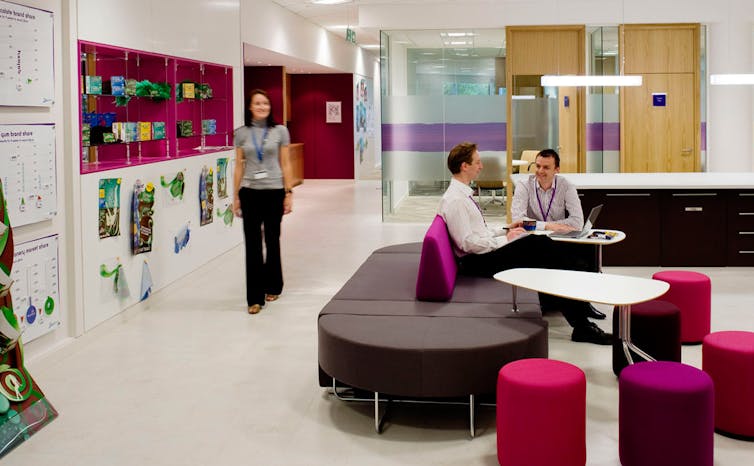
Open plan offices CAN actually work, under certain conditions
Gemma Irving, The University of Queensland
You might be back in your open plan office after holidays, struggling to concentrate and pining for quiet time, but the bad rap open plan offices usually get is not always deserved.
My research found that teams generally had positive experiences in open plan offices. I studied different types of professionals in these office spaces and found it helped engineering teams work together on process improvements. Open plan offices helped business performance teams with initiatives such as building an intranet and a contact database. And this office design helped learning teams produce new online courses.
Read more: Get out of my face! We’re more antisocial in a shared office space
But there are certain conditions crucial to success of the open plan. It helps workers collaborate when they had shared goals and adjusted their behaviour to respect their colleagues’ noise preferences. The workers I studied could overhear useful information, learn from others, and contribute to solving problems in these environments.
Employees valued getting instant help from their team members in the open plan, instead of being distracted or having issues with privacy. They viewed interruptions as an opportunity to help others, rather than as a problem. Team members could access shared whiteboards, flipcharts and drawings to help coordination and improve team productivity.
If you’re going to make the open plan work, rules for sharing the space are also important. These rules help employees to manage the negative impacts of open plan offices.
In one team I studied, employees used flags to signal “do not interrupt”. They also agreed to minimise conversations in the office. Break-out rooms were available for quiet work.
The rules for this team were the result of a formal discussion. For other teams, rules were informal and emerged over time.
Making your open plan office work for you
I found that open plan offices are suitable for collaboration that requires employees to interact frequently on connected tasks. Open plan offices allow employees to quickly exchange information in many short interactions.
But this doesn’t mean you should lean over the desk and have a long chat at will. Lengthy face-to-face or online discussions are usually best carried out in private offices or meeting rooms. This is because people feel free to talk at length when they cannot be overheard.
Other research finds employees in private offices interact less frequently, but overall spend more time interacting than employees in open plan offices. This is backed up by research that also suggests that privacy is an important ingredient for informal interaction.
Read more: The backlash against open-plan offices: segmented space
Open plan offices are also good for teams who need to respond to change. In this context, constant interaction can help teams rapidly assimilate new information.
Although interruptions can have a small, negative impact on the fellow worker’s productivity, the team member who is receiving help will save time. Overall this improves team productivity.
Instead of being unsure of how to perform a task, novices in teams learn when they can observe and ask questions of experts in open plan offices.
It doesn’t work for everyone
Research shows that many people who work in an open plan office have experienced poor relationships with colleagues and reduced job satisfaction and well-being. Other research confirms that the drawbacks of open plan offices often outweigh the benefits.
As part of my reseach I also studied how individual scientists use open plan offices and found that they had difficulty concentrating, managing private conversations and that the shared workspace didn’t improve collaboration.
Scientists preferred to collaborate through intermittent meetings with experts from around the world and did not need to interact with others in their open plan office. Others collaborated using virtual technologies.
![]() While teams might find these offices helpful, many workers still do struggle with the challenges of open plan offices. The key is to match the environment to the interactions employees need to do their job.
While teams might find these offices helpful, many workers still do struggle with the challenges of open plan offices. The key is to match the environment to the interactions employees need to do their job.
Gemma Irving, Postdoctoral Research Fellow in Strategy, The University of Queensland
This article was originally published on The Conversation. Read the original article.



